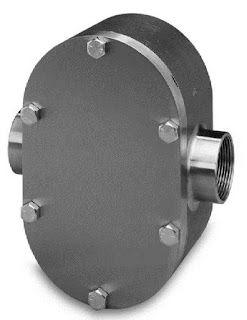 |
| Positive displacement flowmeter Rotating gear type Courtesy Flow Technology |
- Oscillating piston
- Gear
- Nutating disk
- Rotary vane
- Diaphragm
Each of the designs, and any others that would be classified as positive displacement, contain a mechanical structure through which the fluid must travel on its path from source to target. The fluid motion drives the mechanical assembly, which contains pathways of known volume. As the fluid motion drives the positive displacement flowmeter assembly, its rotational, oscillating, or other regular movement is counted, often by electronic means using magnetic pickups on moving assembly. The counts can be used to indicate current flow rate, or totalized to measure total flow volume. Additional inputs about fluid properties can be used to calculate mass flow, as well.
Positive displacement flowmeters can be applied to liquid or gaseous media, with the selection of the mechanical internals being a significant factor in the suitability of a design for a particular application.
Rotating gear flowmeters are especially well suited for high viscosity liquids. As the fluid drives the gear assembly, liquid is trapped in the spaces between the gear lobes and the housing. The rotation of the gear moves the liquid from the inlet port to the outlet. The product datasheet provided below has a good illustration of the geared positive displacement flowmeter operating principle. In many cases, a positive displacement flowmeter appears similar to a positive displacement pump, with the primary difference being that the pump is provided with its own motive power (a motor) and the flowmeter is driven by the process fluid.
Share all of your flow measurement requirements and challenges with process instrumentation experts, combining your own process knowledge and experience with their product application expertise to develop effective solutions.